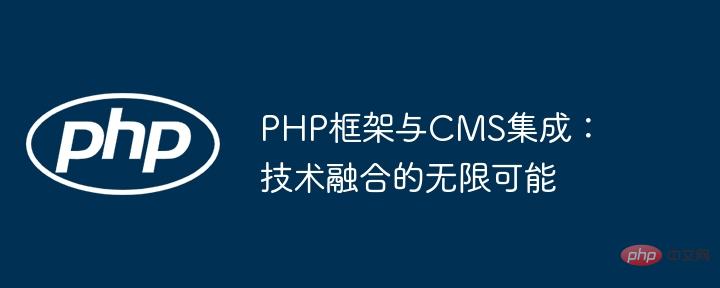 Backend Development
Backend Development
 PHP Tutorial
PHP Tutorial
 PHP framework and CMS integration: unlimited possibilities for technology integration
PHP framework and CMS integration: unlimited possibilities for technology integration
PHP framework and CMS integration: unlimited possibilities for technology integration
The benefits brought by the integration of PHP framework and CMS are: 1. Improve development efficiency; 2. Enhance security; 3. Simplify content management; 4. Flexibility. In a practical case, the Laravel framework was integrated with WordPress CMS to create a blog website with customized functions. The integration steps include creating a Laravel application, installing WordPress, configuring WordPress, creating controllers, defining routes, obtaining WordPress data, and viewing in Laravel Display data in .

Integration of PHP framework and CMS: infinite possibilities of technology integration
Introduction
Integrating PHP frameworks with content management systems (CMS) can bring powerful advantages, enhance website development capabilities and simplify content management. This article explores the benefits of this integration, provides practical examples, and walks you step-by-step through implementing a custom integration.
Benefits
- Improve development efficiency: The framework provides predefined components and structures to simplify the development process. The CMS provides you with the basic functions required for content management, such as adding, editing, and deleting content.
- Enhanced Security: Frameworks and CMS often have built-in security measures, such as SQL injection protection and cross-site scripting (XSS) defense.
- Content Management Simplified: CMS provides a user-friendly interface that enables non-technical people to easily create and manage content without the need for deep knowledge of code.
- Flexibility:Integration allows you to leverage the flexibility of the framework for custom development while retaining the core functionality provided by the CMS.
Practical Case: Laravel and WordPress Integration
We integrate Laravel (a popular PHP framework) with WordPress (a popular CMS) to Create a blog website with custom features.
Steps:
-
Create Laravel application: Create Laravel using
composer create-project laravel/laravelapp. -
Install WordPress: In the
publicdirectory of the Laravel project, install WordPress. -
Configure WordPress: Update the database credentials and URL in the
wp-config.phpfile. -
Create Controller: Create
BlogControllerin your Laravel application. - Define routes: Define routes for controller actions and WordPress REST API endpoints.
- Get data from WordPress: Use the WordPress REST API to get posts and pages.
- Display data in Laravel view: Pass the data obtained from WordPress to the Laravel view and display it.
Conclusion
Integrating PHP framework with CMS can significantly improve website development efficiency, enhance security, simplify content management and provide flexibility. With careful planning and implementation, you can create powerful and scalable applications while unlocking the full potential of both technologies.
The above is the detailed content of PHP framework and CMS integration: unlimited possibilities for technology integration. For more information, please follow other related articles on the PHP Chinese website!

Hot AI Tools

Undresser.AI Undress
AI-powered app for creating realistic nude photos

AI Clothes Remover
Online AI tool for removing clothes from photos.

Undress AI Tool
Undress images for free

Clothoff.io
AI clothes remover

AI Hentai Generator
Generate AI Hentai for free.

Hot Article

Hot Tools

Notepad++7.3.1
Easy-to-use and free code editor

SublimeText3 Chinese version
Chinese version, very easy to use

Zend Studio 13.0.1
Powerful PHP integrated development environment

Dreamweaver CS6
Visual web development tools

SublimeText3 Mac version
God-level code editing software (SublimeText3)

Hot Topics
 1371
1371
 52
52
 PHP 8.4 Installation and Upgrade guide for Ubuntu and Debian
Dec 24, 2024 pm 04:42 PM
PHP 8.4 Installation and Upgrade guide for Ubuntu and Debian
Dec 24, 2024 pm 04:42 PM
PHP 8.4 brings several new features, security improvements, and performance improvements with healthy amounts of feature deprecations and removals. This guide explains how to install PHP 8.4 or upgrade to PHP 8.4 on Ubuntu, Debian, or their derivati
 CakePHP Working with Database
Sep 10, 2024 pm 05:25 PM
CakePHP Working with Database
Sep 10, 2024 pm 05:25 PM
Working with database in CakePHP is very easy. We will understand the CRUD (Create, Read, Update, Delete) operations in this chapter.
 CakePHP Date and Time
Sep 10, 2024 pm 05:27 PM
CakePHP Date and Time
Sep 10, 2024 pm 05:27 PM
To work with date and time in cakephp4, we are going to make use of the available FrozenTime class.
 CakePHP File upload
Sep 10, 2024 pm 05:27 PM
CakePHP File upload
Sep 10, 2024 pm 05:27 PM
To work on file upload we are going to use the form helper. Here, is an example for file upload.
 CakePHP Routing
Sep 10, 2024 pm 05:25 PM
CakePHP Routing
Sep 10, 2024 pm 05:25 PM
In this chapter, we are going to learn the following topics related to routing ?
 Discuss CakePHP
Sep 10, 2024 pm 05:28 PM
Discuss CakePHP
Sep 10, 2024 pm 05:28 PM
CakePHP is an open-source framework for PHP. It is intended to make developing, deploying and maintaining applications much easier. CakePHP is based on a MVC-like architecture that is both powerful and easy to grasp. Models, Views, and Controllers gu
 CakePHP Creating Validators
Sep 10, 2024 pm 05:26 PM
CakePHP Creating Validators
Sep 10, 2024 pm 05:26 PM
Validator can be created by adding the following two lines in the controller.
 How To Set Up Visual Studio Code (VS Code) for PHP Development
Dec 20, 2024 am 11:31 AM
How To Set Up Visual Studio Code (VS Code) for PHP Development
Dec 20, 2024 am 11:31 AM
Visual Studio Code, also known as VS Code, is a free source code editor — or integrated development environment (IDE) — available for all major operating systems. With a large collection of extensions for many programming languages, VS Code can be c



